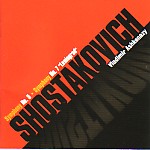This reissue of two fine, very well engineered Shostakovich symphony performances vividly illustrates what went wrong with the classical recording industry, particularly at the major labels, during the last two decades. Under any normal circumstances these recordings would have been welcomed with open arms. Ashkenazy, although noted primarily as a pianist, is a solid conductor with an obvious and persuasive identification with Russian music (and a few other composers besides). His Shostakovich cycle, which seems destined to remain incomplete unless the rest of it is sitting “in the can” somewhere at Decca, was uniformly good–in fact some of the best work that he has done on the podium. But it hardly mattered because by the time it started coming out, the market already was saturated past the point where most collectors were prepared to care.
Take this recording of the “Leningrad” Symphony. It’s splendid in every way: exciting, marvelously played, propulsive and beautifully paced in the tough-to-bring-off first movement, and containing one of the best final perorations on disc. Having the former “Leningrad” orchestra on hand certainly was a plus, save for the fact that Jansons already had an equally fine version available with this same orchestra on EMI (and so did Temirkanov, perhaps a bit less interesting, on RCA). Toss in the much-acclaimed Bernstein/Chicago (DG) and the similarly powerful (but very different) Järvi/Scottish National Orchestra (Chandos), and how many versions of this symphony does anyone need? It’s not the kind of piece that tends to yield a wide variety of interpretive revelations. All it takes is top-notch playing and engineering, and a conductor who knows how to keep the piece moving, pulling out all of the stops when necessary–not terribly difficult requirements. Very good though this is, and eminently recommendable, it wasn’t (and isn’t) terribly necessary.
The same argument applies to the Fifth Symphony, only more so because the competition is so much more intense. True, there is more opportunity for interpretive latitude in this work, particularly with respect to the tempo of the slow movement and the conductor’s handling of the emotionally ambivalent (at least potentially) coda of the finale. In this last respect Ashkenazy takes a middle path, neither agonizingly grinding out the final bars like Sanderling (Berlin Classics) nor opting for all-out triumph like Ormandy (Sony or RCA). His approach, then, resembles quite literally dozens of others, the best of which is probably Haitink’s, also on Decca, and however well the Royal Philharmonic plays (and it sounds terrific), it still doesn’t quite match the polish and intensity of the Concertgebouw under the Dutch conductor. Even the spectacular account of the Festive Overture, surely one of the best versions available of this delightful work, fails to tip the balance in any significant way. So while I can recommend this set without hesitation, the reality is that you can do as well or even better many times over, and most serious collectors likely already have.
































